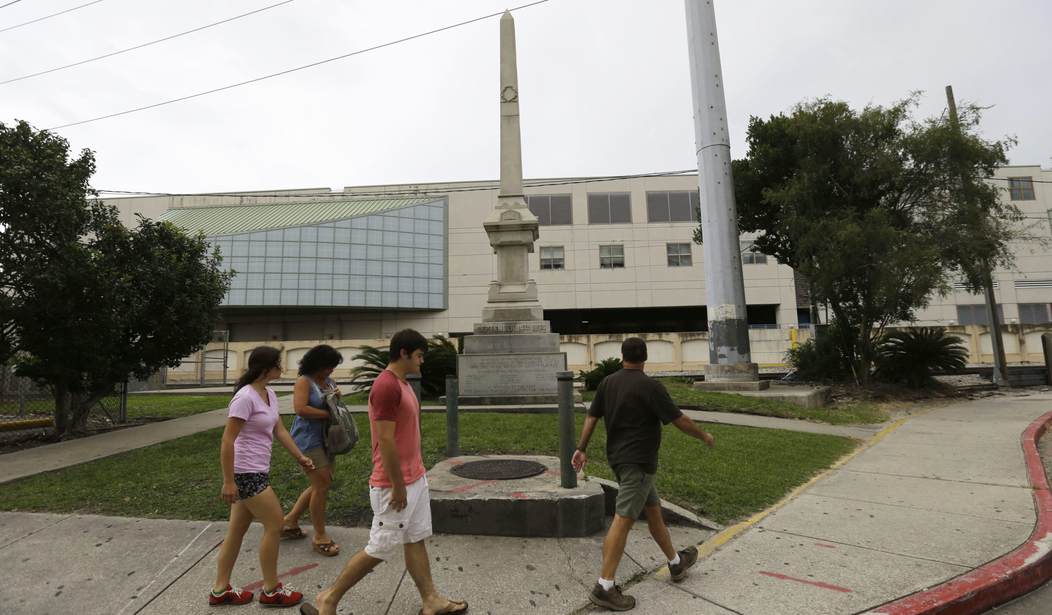In the wee hours of Monday morning — the day celebrated as Confederate Memorial Day in other southern states — workers dressed in black vests and wearing pieces of cloth to cover their faces removed a monument in New Orleans, La. During one part of its history, the Battle of Liberty Place statue actually enshrined “white supremacy” in a plaque.
“The removal of these statues sends a clear and unequivocal message to the people of New Orleans and the nation: New Orleans celebrates our diversity, inclusion and tolerance,” declared Mayor Mitch Landrieu in a statement Monday. He insisted that “relocating these Confederate monuments is not about taking something away from someone else.”
Landrieu argued that “this is not about politics, blame or retaliation. This is not a naïve quest to solve all our problems at once. This is about showing the whole world that we as a city and as a people are able to acknowledge, understand, reconcile — and most importantly — choose a better future.”
The New Orleans mayor insisted that “we can remember these divisive chapters in our history in a museum or other facility where they can be put in context — and that’s where these statues belong.”
The removal began just before 1:30 a.m. Eastern, after a small group of protesters departed from the monument and a wave of officers with the New Orleans Police Department barricaded points of entry to the monument, The Times-Picayune reported. Snipers were stationed on the parking deck looking down at the monument.
Just before 2:15 a.m., two flatbed trucks arrived at the monument, carrying equipment to haul it away. The name of the company on the truck’s sides was concealed by tape and cardboard, and the workers wore black vests, yellow helmets, and pieces of cloth to cover their faces. Just before 3 a.m., workers started drilling to remove the obelisk.
The monument was driven away around 5:35 a.m.
The Battle of Liberty Place monument seems ideally chosen to fit Landrieu’s statement. According to Landrieu’s statement, it was erected in 1891 to commemorate the “Battle of Liberty Place,” a 1874 insurrection of the Crescent City White League, a group of all white, mostly Confederate veterans, who battled against the racially integrated New Orleans Metropolitan Police force and state militia.
In 1932, the city of New Orleans added a plaque to the monument, explaining the battle was fought for the “overthrow of the carpetbag government, ousting the usurpers.” The plaque also explicitly declared that “the national election of November 1876 recognized white supremacy in the South and gave us our state.”
That plaque remained until 1989, when the monument was moved, and a new plaque was printed, reading: “In honor of those Americans on both sides who died in the Battle of Liberty Place… A conflict of the past that should teach us lessons for the future.”
Despite this newer plaque, the history of the monument’s full support for white supremacy — by name — makes it ideally suited as a symbol to hail diversity.
Indeed, such a monument belongs in a museum, not on a city’s streets. But it is just one of four monuments slated for removal, and not all of them are as clear-cut.
Other monuments slated for removal include the Robert E. Lee statue, the Jefferson Davis statue, and the P.G.T. Beauregard equestrian statue. Mayor Landrieu signed an ordinance calling for the removal and relocation of these four monuments in December 2015, and members of the City Council voted 6-1 in support of it. That ordinance formally declared all four statues to be “nuisances pursuant to Section 146-611 of the City Code of New Orleans.”
The city of New Orleans is doing it's part to atone for its racist history by removing several confederate statues: https://t.co/XJM4riaVWA pic.twitter.com/GpOzwh6zmn
— The Root (@TheRoot) April 24, 2017
Landrieu’s statement declared that “the statues were erected decades after the Civil War was over as part of the ‘Cult of the Lost Cause’ and to demonstrate that there was no sense of guilt for the cause in which the South fought the Civil War.”
Regarding the Robert E. Lee statue in particular, the mayor noted that Lee himself had never set foot in New Orleans. The difficulty with this is that Lee was a consummate general who opposed slavery and fought for his native Virginia, not for the Confederate cause. Celebrating him is markedly different from celebrating the Battle of Liberty Place. The Liberty Place monument not only had the “white supremacy” declaration on it, but it commemorated an insurrection against the federal government after the war. While Reconstruction was heavy-handed, this event is not something to celebrate.
Monday’s removal of the Liberty Place memorial was indeed a symbol of New Orleans’ inclusivity and rejection of white supremacy. It is a tragedy that the removal had to take place in the middle of the night with snipers and with the identity of the company and the workers kept anonymous. But perhaps this was the wisest move, given protests on both sides.
Each of the four monuments in question had been vandalized, with “Black Lives Matter” spray-painted on the Beauregard statue in 2015.
But opposition to the removals also ran strong, with a lawsuit seeking to halt the removal reaching the 5th Circuit U.S. Court of Appeals in March. Ultimately, the suit was struck down.
Death threats followed the 2015 decision that New Orleans would be removing the monuments. Those threats, including the discovery of a $200,000 Lamborghini burned to a crisp, prompted the first contractor, H&O Investments of Baton Rouge, to quit the job last January.
The debate about remembering the Confederacy reached a fever pitch in 2015 after a white supremacist who posted pictures of himself with a well-known flag from the Confederacy on social media carried out a shooting in a historically black church in Charleston, South Carolina. Many responded by declaring all symbols of the Confederacy racist and demanding their removal from polite society.
Others responded to this backlash by championing such symbols as a reminder of history — something to be remembered. Mississippi Governor Phil Bryant issued a proclamation in 2016 declaring April Confederate Heritage Month in his state. He defended that proclamation, saying “history deserves study and reflection, no matter how unpleasant or complicated parts of it may be.”
This year, Bryant also declared April 24 Confederate Memorial Day. “It is important for all Americans to reflect upon our nation’s past,” his proclamation read.
While the Battle of Liberty Place memorial arguably deserved to be removed, its removal on this day might spark outrage among defenders of Confederate symbols.








Join the conversation as a VIP Member